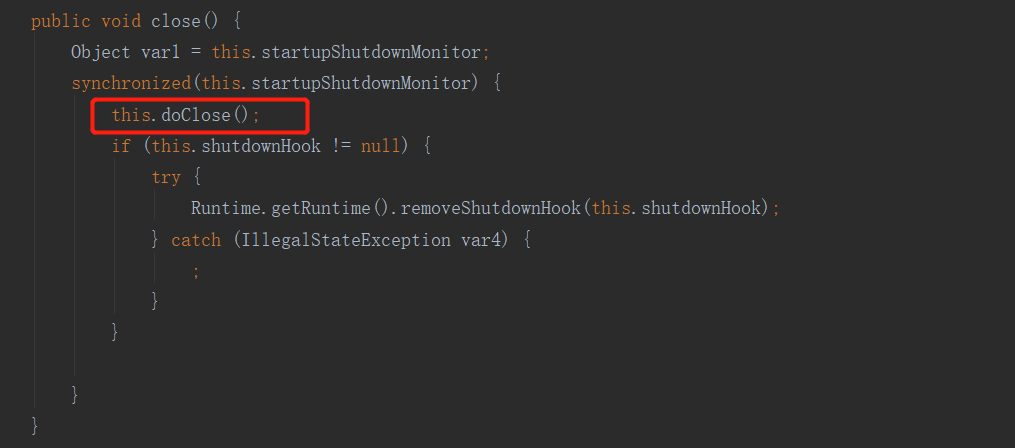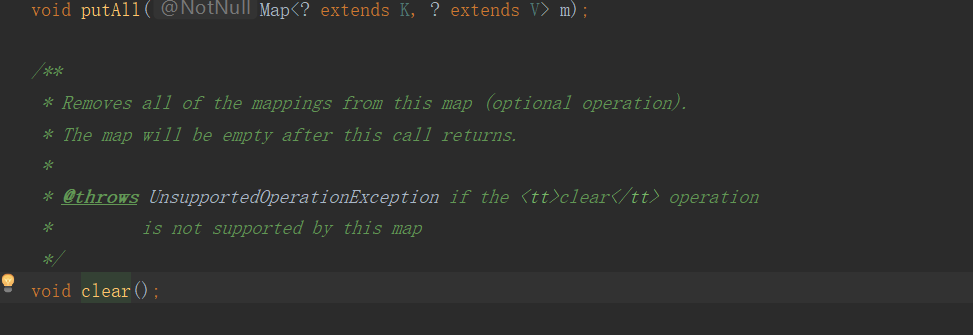生命周期
创建 ----> 初始化 ---> 销毁
1. 实例化对象
2. setter注入,执行Bean的属性依赖注入
3. BeanNameAware的setBeanName(), 如果实现该接口,则执行其setBeanName 方法
4.BeanFactoryAware的setBeanFactory(), 如果实现该接口,则执行其setBeanFactory方法
5. BeanPostProcessor的processBeforeInitialization(),如果有关联的processor,则在Bean初始化之前都会执行这个实例的processBeforeInitialization() 方法
6. InitializingBean的afterPropertiesSet(), 如果实现了该接口,则执行其afterPropertiesSet()方法。Bean定义文件中定义init-method
7.BeanPostProcessors的processAfterInitialization(),如果有关联的processor,则在Bean初始化之前都会执行这个实例的processAfterInitialization()方法
8.DisposeablebBean的 destory(),在容器关闭时,如果Bean实现了这个接口,则执行他的destory()方法
9. Bean定义文件中定义destroy-method,在容器关闭时,可以在Bean定义文件中使用“destory-method”定义的方法
注:
1. 单例默认时在容器被嘉爱时候会初始化
2. 多例在每次获取Bean的对象时候才会去初始化
bean 初始化 指的就是对象已经创建里面所有的set方法都已经执行完毕了。 指定方法执行
@Bean(initMethod , destory) 指定初始化和销毁方法 同时在bean中创建这两个方法
init是在构造方法之前还是之后执行? 无参构造! 对象先创建完成后才进行初始化!所以先执行无参构造函数!
补充到上面的过程:
Bean的创建(执行构造函数) --> 初始化(自定义init方法) --> 销毁
调用close() 方法销毁单例对象
注意:IOC容器使用Map结合存储对象,clear() 清除对象
看源码:

进入查看:

继续点击查看:

看第一个:

持续跟进后就是 集合的 clear 方法了

我们可以通过实现某些类 去进行初始化的操作!
开发使用的方式:
方法一: 通过@Bean指定init-method 和 destory-method
方法二: 通过让Bean实现InitializingBean(定义初始化逻辑), DisposableBean(定义销毁逻辑)
方法三: 使用JSR250(Java规范,不是Spring的): @PostConstructo: 在Bean创建完成并且赋值完成,来执行初始化方法。 @PreDestory: 在容器销毁Bean之前通知我们进行清理工作
方法二:
Bean:
@Component public class LifeBean implements InitializingBean, DisposableBean { //构造函数 public LifeBean() { System.out.println("LifeBean Constructor"); } /** 接口InitializingBean的方法 * //解释 对象有创建 肯定也有给属相赋值的过程!,对象赋值完毕以后才执行该方法 即: (afterPropertiesSet)中文:set方法都走完了时候执行该方法 * @throws Exception */ @Override public void afterPropertiesSet() throws Exception { //等同于 @Bean(init =" ") //解释 对象有创建 肯定也有给属相赋值的过程!,对象赋值完毕以后才执行该方法 System.out.println("LifeBean ********> 【InitializingBean.afterPropertiesSet】 "); } /** * 接口DisposableBean 的方法 * @throws Exception */ @Override public void destroy() throws Exception { System.out.println("LifeBean ********>【DisposableBean.destroy】"); } }
配置和扫包
@Configuration @ComponentScan("com.toov5.config.beanTest.entity") public class MyConfig { }
启动测试:
public class test { public test(){ } public static void main(String[] args) { AnnotationConfigApplicationContext applicationContext1 = new AnnotationConfigApplicationContext("com.toov5.config"); applicationContext1.close(); // System.out.println(applicationContext1); } }

方法三
注解代替了接口:
Bean:
@Component public class LifeBean { //构造函数 public LifeBean() { System.out.println("LifeBean Constructor"); } @PostConstruct public void afterPropertiesSet() throws Exception { //等同于 @Bean(init =" ") //解释 对象有创建 肯定也有给属相赋值的过程!,对象赋值完毕以后才执行该方法 System.out.println("LifeBean ********> 【InitializingBean.afterPropertiesSet】 "); } @PreDestroy public void destroy() throws Exception { System.out.println("LifeBean ********>【DisposableBean.destroy】"); } }
效果是一样的:

Spring Bean生命周期中的后置处理器: BeanPostProcessor接口
过滤器中,不可以使用注解方式获取Bean对象。 做法: 单独获取上下文ApplicationContext
后置处理器,实现对Bean初始化增强功能
@Component public class MyApplicationContext implements ApplicationContextAware { //开发时候经常做成全局的 进行使用 private ApplicationContext applicationContext; @Override public void setApplicationContext(ApplicationContext applicationContext) throws BeansException { LifeBean lifeBean = applicationContext.getBean("lifeBean", LifeBean.class); System.out.println("result————————————————————"+lifeBean.toString()); } }
运行后:结果是没问题的
